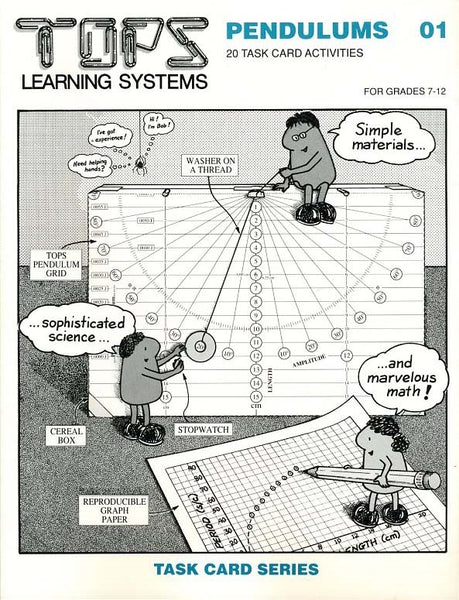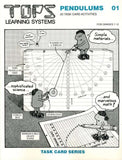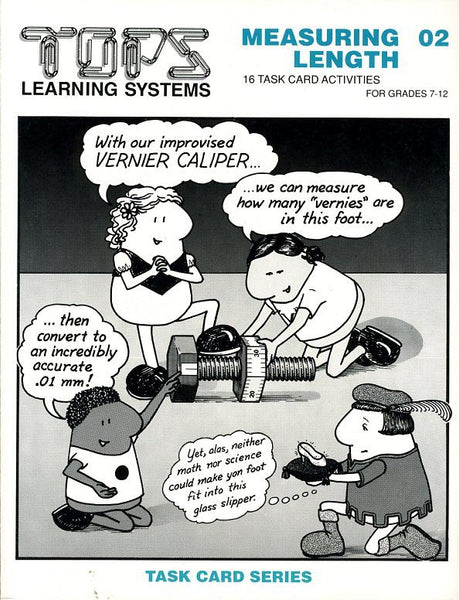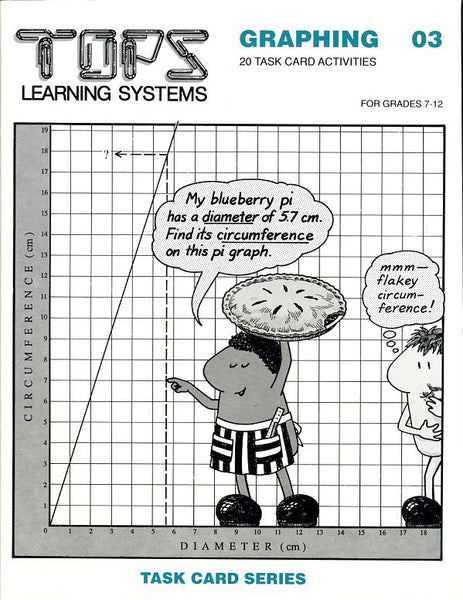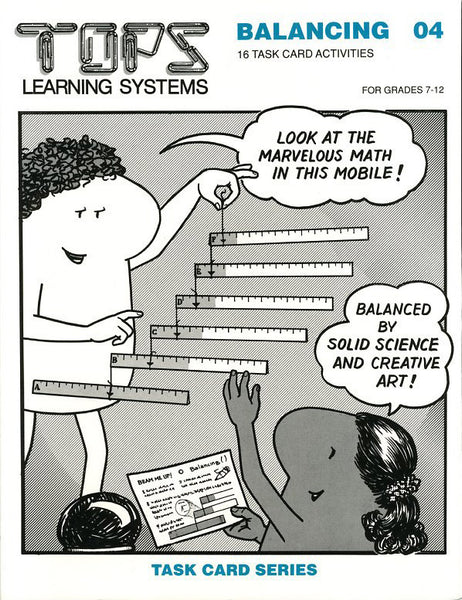#01 Pendulums (grades 8-12)
Regular price $19.95
More Information – click any of the tabs below to learn more about this title
Click here for a complete list of materials needed and convenient shopping.
cereal boxes (two pound Grape Nuts boxes are ideal), gravel (sand or soil), masking tape, scissors, spools thread, washers, paper clips of uniform size, wall clock, stopwatches, hand calculators, roll thin, bare iron wire, meter sticks, wire cutters, batteries, size-D, dead or alive, clothespins, index cards (any straight edge), straws, straight pins, 4 1/2 inch plastic lids from margarine tubs or coffee tins, paper punches, a working video screen
- Lesson 1: To construct a cereal-box pendulum support with a length and amplitude background grid for use in activities throughout this module.
- Lesson 2: To find the frequency of a pendulum in cycles per minute for various lengths. To summarize how the frequency of a pendulum varies with length.
- Lesson 3: To convert pendulum frequencies from cycles per minute to cycles per second, or hertz units. To graph how the frequency of a pendulum varies with length.
- Lesson 4: To find the period of a pendulum in seconds per cycle for various lengths. To summarize how the period of a pendulum varies with length.
- Lesson 5: To understand the inverse relationship between period and frequency, both mathematically and graphically.
- Lesson 6: To evaluate the relative effects of length, amplitude and bob weight on the period of a pendulum.
- Lesson 7: To apply concepts and skills in the study of washer pendulums to a new oscillating system -- a spring pendulum.
- Lesson 8: To extrapolate the graph line of length vs. period to longer lengths. To evaluate the accuracy of this prediction.
- Lesson 9: To graph how the length of a pendulum varies with the square of its period. To observe that the ratio of these variables yields a constant number.
- Lesson 10: To derive an equation that relates the length of a pendulum to its period. To apply this equation in a predictive way and confirm that it is valid.
- Lesson 11: To graph how the period of a paper-clip chain changes with length. To compare its graph line with a thread and washer pendulum.
- Lesson 12: To apply concepts and skills learned with thread pendulums to paper clip pendulums. To develop an equation relating the period of a paper clip chain to the number of clips it contains.
- Lesson 13: To experimentally calculate square roots using pendulum variables.
- Lesson 14: To study how pendulums receive energy pulses at simple multiples of their own natural frequency.
- Lesson 15: To transfer energy between pendulums of equal and unequal length. To account for observed differences in terms of frequency and phase.
- Lesson 16: To examine a pendulum system with two distinct pivot points. To develop an equation for calculating its period.
- Lesson 17: To study energy transformations in a swinging pendulum. To understand that energy in the bob is always conserved.
- Lesson 18: To graphically analyze how energy in a pendulum system changes forms.
- Lesson 19: To graph the energy of a washer that revolves full circle. To compare this system to a low-amplitude pendulum.
- Lesson 20: To calculate the refresh rate of a video screen in hertz units.
National Science Education Standards (NRC 1996)
TEACHING Standards
These 20 Task Cards promote excellence in science teaching by these NSES criteria:Teachers of science...
A: ...plan an inquiry-based science program. (p. 30)
B: ...guide and facilitate learning. (p. 32)
C: ...engage in ongoing assessment of their teaching and of student learning. (p. 37)
D: ...design and manage learning environments that provide students with the time, space, and resources needed for learning science. (p. 43)
CONTENT Standards
These 20 Task Cards contain fundamental content as defined by these NSES guidelines (p. 109).• Represent a central event or phenomenon in the natural world.
• Represent a central scientific idea and organizing principle.
• Have rich explanatory power.
• Guide fruitful investigations.
• Apply to situations and contexts common to everyday experiences.
• Can be linked to meaningful learning experiences.
• Are developmentally appropriate for students at the grade level specified.
Unifying Concepts and Processes
NSES Framework: Systems, order, and organization • Evidence, models and explanation • Constancy, change, and measurement • Evolution and equilibrium • Form and functionCore Concepts/Processes: Explore change, constancy, measurement and pattern in pendulum systems. • Study frequency variables that really matter (length); that don't matter (bob weight); that matter a little (amplitude).
Science as Inquiry (content standard A)
NSES Framework: Identify questions that can be answered through scientific investigations. • Design and conduct a scientific investigation. • Use appropriate tools and techniques to gather, analyze, and interpret data. • Develop descriptions, explanations, predictions, and models using evidence. • Think critically and logically to connect evidence and explanations. • Recognize and analyze alternative explanations and predictions. • Communicate scientific procedures and explanations. • Use mathematics in all aspects of scientific inquiry.Core Inquiries: Time Pendulums • Measure Lengths • Record Data • Graph Variables • Predict Frequency
Physical Science (content standard B)
NSES Framework: Motions and forces • Transfer of energy • Conservation of energy Core Content: Explore how length, amplitude and bob weight affect pendulum frequencies and periods. • Collect and graph data. • Examine energy transfers.Science and Technology (content standard E)
NSES Framework: Abilities of technological design • Understanding about science and technology Core Content: Study levers, pulleys, inclined planes, wheels and axles, and gears.
